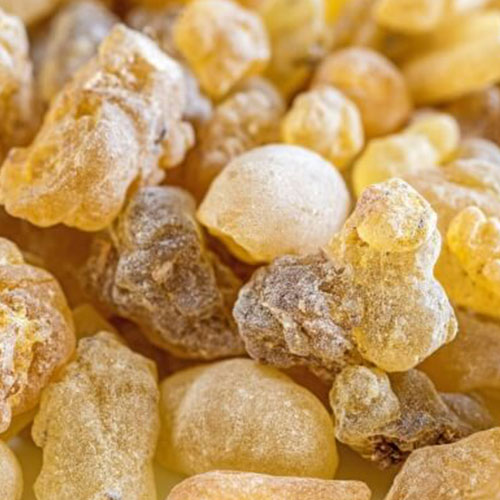Frankincense Carteri CO2-se extract
Product-No.: 038.002
Raw Material:
Boswellia carteri – Resin
Production:
By supercritical fluid extraction with natural carbon dioxide no solvent residues, no inorganic salts, no heavy metals, no reproducible microorganisms [1].
Ingredients:
see specification
Application:
In folk medicine, frankincense extract is used internally for hoarseness and inflammation of the pharyngeal mucosa, externally (as an ointment or plaster) for abscesses, inflammation of the ovaries and inflammation of the fallopian tubes. The effectiveness of the drug in the above-mentioned indications has not been proven [2].*
The essential oil of frankincense carteri has a resinous incense base note rounded off with lemon, camphor and woody leg notes with a slightly sweet, spicy nuance and a hint of orange [3]. Due to its diverse fragrance profile, the essential oil is used in the perfume industry. Furthermore, the essential oil of frankincense Carteri has antibacterial properties against bacteria such as Staphylococcus aureus or Escherichia coli and is therefore also suitable as a natural preservative in cosmetic products [4].*
Literature:
[1] P. Manninen, E. Häivälä, S. Sarimo, H. Kallio : Distribution of microbes in supercritical CO2 extraction of sea buckthorn (Hippophae rhamnoides) oils : Zeitschrift für Lebensmitteluntersuchung und -Forschung / Springerverlag (1997) 204: 202-205
[2] Wolfgang Blascheck u.a. (Hrsg.) : HagerROM 2017, Hagers Enzyklopädie der Arzneistoffe und Drogen : Suttgart: Wissenschaftliche Verlagsgesellschaft Stuttgart, 2017
[3] Niebler J, Buettner A : Identification of odorants in frankincense (Boswellia sacra Flueck.) by aroma extract dilution analysis and two-dimensional gas chromatography-mass spectrometry/olfactometry : Phytochemistry 109, 66-75, 2015
[4] SS Hassona, MS Al-Balushia,TA Sallamc, MA Idrisb, O Habbala, AA Al-Jabria : In vitro antibacterial activity of three medicinal plants-Boswellia (Luban) species : Asian Pacific Journal of Tropical Biomedicine, Volume 1, Issue 2, Supplement, October 2011, Pages S178-S182
